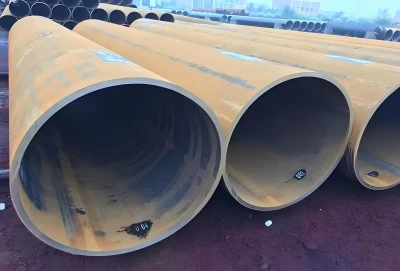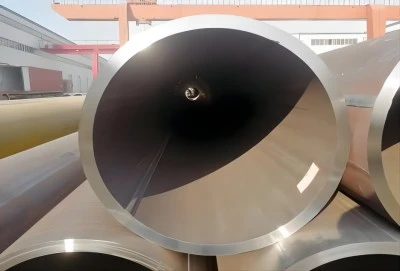ASTM A672 is a widely used standard specification for electric-fusion-welded steel pipes for high-pressure service at moderate temperatures. Understanding the chemical composition of ASTM A672 is crucial for engineers, manufacturers, and end-users working with these pipes. In this comprehensive guide, we'll explore the chemical makeup of ASTM A672 steel, its primary elements, and how they affect the material's properties and performance.
|
|
|
The Chemical Composition of ASTM A672 Steel
ASTM A672 steel is a low-alloy, high-strength material specifically designed for use in pressure vessels and piping systems. The chemical composition of ASTM A672 varies slightly depending on the grade, but generally includes the following elements:
- Carbon (C)
- Manganese (Mn)
- Silicon (Si)
- Phosphorus (P)
- Sulfur (S)
- Nickel (Ni)
- Chromium (Cr)
- Molybdenum (Mo)
- Copper (Cu)
- Vanadium (V)
Each of these elements plays a specific role in determining the properties and performance of ASTM A672 pipe. The precise percentages of these elements can vary depending on the grade of steel and the specific requirements of the application.
Primary Elements in ASTM A672 Steel and Their Roles
Let's take a closer look at the primary elements found in ASTM A672 steel and their contributions to the material's properties:
1. Carbon (C)
Carbon is the most critical alloying element in steel, including ASTM A672. It primarily influences the steel's strength, hardness, and weldability. In ASTM A672, the carbon content typically ranges from 0.18% to 0.31%, depending on the grade. Higher carbon content increases strength and hardness but can reduce ductility and weldability.
2. Manganese (Mn)
Manganese is added to ASTM A672 steel to improve its strength, toughness, and hardenability. It also helps to deoxidize the steel during the manufacturing process. The manganese content in ASTM A672 usually ranges from 0.60% to 1.35%. Manganese also enhances the steel's resistance to wear and abrasion.
3. Silicon (Si)
Silicon acts as a deoxidizer in the steelmaking process and contributes to the strength and hardness of ASTM A672 steel. The silicon content typically ranges from 0.15% to 0.50%. Silicon also improves the steel's resistance to scaling at high temperatures.
4. Phosphorus (P) and Sulfur (S)
Phosphorus and sulfur are considered impurities in steel and are kept to minimum levels in ASTM A672. The maximum allowable content for both elements is usually 0.035%. These elements can negatively impact the steel's mechanical properties and weldability if present in higher concentrations.
5. Nickel (Ni)
Nickel is added to some grades of ASTM A672 steel to enhance toughness, particularly at low temperatures. It also improves the steel's corrosion resistance. The nickel content can vary depending on the specific grade and application requirements.
6. Chromium (Cr)
Chromium contributes to the hardenability and corrosion resistance of ASTM A672 steel. It forms a protective oxide layer on the steel's surface, enhancing its resistance to various corrosive environments. The chromium content in ASTM A672 can vary depending on the grade.
7. Molybdenum (Mo)
Molybdenum is added to certain grades of ASTM A672 steel to improve its strength, particularly at elevated temperatures. It also enhances the steel's resistance to creep and improves its weldability. The molybdenum content typically ranges from 0.08% to 0.15% in applicable grades.
8. Copper (Cu)
Copper is sometimes added to ASTM A672 steel to improve its atmospheric corrosion resistance. It can also contribute to the steel's strength through precipitation hardening. The copper content is usually limited to a maximum of 0.35%.
9. Vanadium (V)
Vanadium is a microalloying element that can be added to ASTM A672 steel to improve its strength and toughness. It forms fine carbides that contribute to grain refinement and precipitation strengthening. The vanadium content is typically kept below 0.08%.
Impact of Chemical Composition on Mechanical Properties
The chemical composition of ASTM A672 steel significantly influences its mechanical properties, which are crucial for its performance in high-pressure service applications. Here's how the chemical composition affects some key mechanical properties:
1. Tensile Strength
The tensile strength of ASTM A672 pipe is primarily influenced by its carbon content, with contributions from other alloying elements such as manganese, silicon, and molybdenum. Higher carbon content generally results in higher tensile strength. For example, ASTM A672 Grade C70 has a higher carbon content and consequently higher tensile strength compared to Grade C60.
2. Yield Strength
Similar to tensile strength, the yield strength of ASTM A672 steel is affected by its carbon content and other strengthening elements. Manganese, in particular, plays a significant role in increasing the yield strength without substantially reducing ductility.
3. Ductility
The ductility of ASTM A672 steel is inversely related to its strength. Higher carbon and alloy content, while increasing strength, can reduce ductility. This is why ASTM A672 specifications often include requirements for elongation to ensure adequate ductility for the intended applications.
4. Toughness
Toughness, which is the ability of the material to absorb energy before fracturing, is influenced by several alloying elements. Nickel, in particular, enhances the toughness of ASTM A672 steel, especially at low temperatures. The balance of carbon, manganese, and other alloying elements also plays a crucial role in determining the steel's toughness.
5. Weldability
The weldability of ASTM A672 pipe is a critical property for its fabrication and installation. The carbon equivalent (CE) of the steel, which takes into account the effects of various alloying elements, is a key indicator of weldability. Lower CE values generally indicate better weldability. The presence of elements like molybdenum can improve weldability by reducing the susceptibility to heat-affected zone cracking.
6. Corrosion Resistance
While ASTM A672 is not primarily designed for corrosion resistance, certain alloying elements can enhance its performance in corrosive environments. Chromium, copper, and to some extent, nickel contribute to improved corrosion resistance. This can be particularly important for ASTM A672 pipes used in applications where exposure to corrosive media is expected.
Understanding the relationship between chemical composition and mechanical properties is crucial for selecting the appropriate grade of ASTM A672 pipe for specific applications. Engineers and designers must consider the balance between strength, ductility, toughness, and other properties based on the intended service conditions.
The Role of Alloying Elements in ASTM A672 Steel Pipe
Alloying elements play a crucial role in determining the properties and performance of ASTM A672 steel pipe. Each element contributes uniquely to the overall characteristics of the material. Let's explore the specific roles of key alloying elements in ASTM A672 steel pipe:
1. Carbon (C)
Carbon is the primary strengthening element in ASTM A672 steel. It forms iron carbides, which increase the steel's hardness and strength. However, higher carbon content can reduce ductility and weldability. In ASTM A672 pipe, the carbon content is carefully controlled to achieve the desired balance between strength and formability.
2. Manganese (Mn)
Manganese serves multiple purposes in ASTM A672 steel pipe:
- It acts as a deoxidizer during the steelmaking process.
- It enhances hardenability, allowing the steel to achieve higher strength levels.
- It contributes to solid solution strengthening, improving both yield and tensile strength.
- It helps in controlling sulfur, forming manganese sulfides instead of iron sulfides, which can cause hot shortness.
The balanced addition of manganese is crucial for achieving the desired mechanical properties in ASTM A672 pipe.
3. Silicon (Si)
Silicon in ASTM A672 steel pipe primarily acts as a deoxidizer, helping to remove oxygen from the molten steel during production. It also contributes to solid solution strengthening, increasing the steel's yield strength. Additionally, silicon improves the steel's resistance to high-temperature oxidation, which can be beneficial in certain applications.
4. Nickel (Ni)
Nickel is added to some grades of ASTM A672 steel pipe to enhance toughness, particularly at low temperatures. It also improves the steel's hardenability without significantly reducing ductility. In applications where low-temperature toughness is critical, nickel-containing grades of ASTM A672 may be preferred.
5. Chromium (Cr)
Chromium in ASTM A672 steel pipe serves several purposes:
- It increases hardenability, allowing for the development of higher strength levels.
- It enhances corrosion resistance by forming a protective oxide layer on the steel's surface.
- It contributes to the formation of various carbides, which can improve wear resistance.
The addition of chromium must be carefully controlled to maintain the desired balance of properties.
6. Molybdenum (Mo)
Molybdenum is a powerful alloying element in ASTM A672 steel pipe:
- It significantly enhances the steel's hardenability.
- It improves the steel's strength at elevated temperatures.
- It contributes to the steel's resistance to temper embrittlement.
- It enhances the steel's resistance to creep, which is crucial for high-temperature applications.
Molybdenum-containing grades of ASTM A672 are often used in applications requiring good high-temperature strength.
7. Vanadium (V)
Vanadium, when present in ASTM A672 steel pipe, acts as a grain refiner and precipitation strengthener:
- It forms fine vanadium carbides, which contribute to grain refinement during heat treatment.
- These fine carbides also provide precipitation strengthening, enhancing the steel's strength without significantly reducing ductility.
- Vanadium improves the steel's resistance to softening at elevated temperatures.
The addition of vanadium can be particularly beneficial in achieving a good combination of strength and toughness in ASTM A672 pipe.
8. Copper (Cu)
Copper, when added to ASTM A672 steel pipe, primarily enhances atmospheric corrosion resistance:
- It forms a protective patina on the steel's surface, reducing corrosion rates in certain environments.
- In some cases, copper can contribute to precipitation hardening, providing additional strength.
The use of copper-containing grades of ASTM A672 may be advantageous in applications where improved atmospheric corrosion resistance is desired [24].
The careful balance of these alloying elements in ASTM A672 steel pipe is crucial for achieving the desired combination of properties. Manufacturers must consider the specific requirements of the intended application when selecting the appropriate grade and composition of ASTM A672 pipe.
Contact Information
Understanding the chemical composition of ASTM A672 steel pipe is essential for ensuring its optimal performance in high-pressure service applications. The careful balance of alloying elements contributes to the material's strength, toughness, weldability, and corrosion resistance. Engineers and manufacturers must consider these factors when selecting the appropriate grade of A672 pipe for their specific needs.
If you're looking for high-quality ASTM A672 pipes that meet your project's exacting requirements, look no further than Longma Group. Our expertise in manufacturing ERW and LSAW steel pipes, including ASTM A672 grades, ensures that you receive products that excel in performance and reliability. Don't hesitate to reach out to our team to discuss how our pipes can enhance your industrial applications. Contact us today at info@longma-group.com to learn more about our products and how we can support your project needs.














